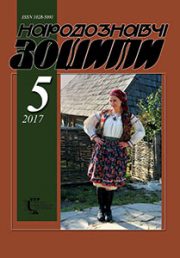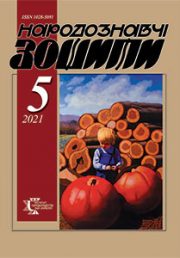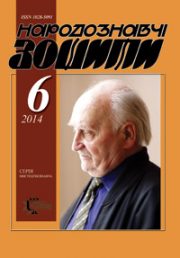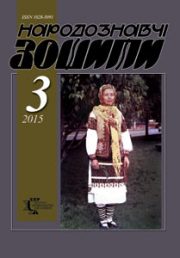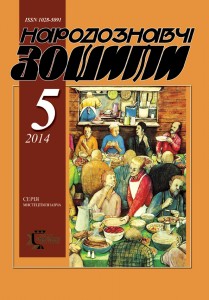
Hanna Pokotylo. This is culture that will strengthen new Ukraine (from the sphere of culturological views). In 80th anniversary of Mykhailo Hrushevsky’s death. P. 827-831
Mykhailo Hrushevsky had obviously been great figure of Ukrainian culture. Universality of his personality, productivity of his research-works, activity in the state matters have proven Hrushevsky’s efforts as historian, culturologist, literature expert, art scholar, ethnologist, fictionist, critic, organizer of science and statesman. Truly, he had belonged to a type of Renaissance persons. Forwarding national idea as a dominant one in his work, Hrushevsky had convincingly claimed that pro-Ukrainian attitudes still contained ancient sources of people’s history, language, traditions, millennia of unbroken existence. He had trusted in the fact, that history of the people and folk culture belonged to inseparable entities. History – in Hrushevsky’s view – is the process of people’s self-realization with unique psycho-physical and spiritual characteristics. He had emphasized that world culture realized itself only through national cultures, as in the case of universal values expressed by means of national ones. Concentrated expression for this unity of national and universal matters he had seen in L. Ukrainka’s and O. Oles’ creations. National cultural development had been determined by him as a natural integration of artistic and human values into universal cultural evolution. Mastering of the native language has played quite important role in the implementation of those ideas. This approach might lead not to the «culture of beauty» only but also to a «culture of life».
Keywords: Mykhailo Hrushevsky, nation, history, culture, statehood, national idea, national consciousness, art.
read »
Maryana Lewytska. A tree as symbol of T. Shevchenko’s fine artistry. P. 832-836
The article has brought analytical study as for the image of tree being polysemantic symbol in T. Shevchenko’s painting. Various semiotic levels of mythological and folklore significance dependent on painter’s conceptions have been considered in comparison of poetic and fine-artistic creations; especial selection of works depicting transformation of landscape tree into deep symbolic figure has been presented.
Keywords: Taras Shevchenko, symbol, tree, figurative dominant.
read »
Nadiya Yurchenko. Iryna Hurtovenko’s graphical shevchenkiana. P. 837-839
In the article have been reported some main problems in creative activities by Iryna Hurtovenko (1965—2005), Sumy graphical artist and her interpretation of Shevchenkian theme with consequent analytical consideration of most representative series and sheets.
Keywords: graphical art, Shevchenkian theme, people’s tradition, poetry, series, sheet, image, incarnation.
read »
Ludmyla Metka. On Vasyl Omelianenko, laureate of Taras Shevchenko state prize of Ukraine, folk artist of decorative clfe sculpture. Years of childhood and youth. P. 840-848
In the article have been considered some origins in creativeness of Basil Omelіanenko, widely-known artist of clay decorative sculpture, laureate of Taras Shevchenko State Prize from the village of Oposhnya, Poltava oblast. Systematized informations about his childhood and youth have been presented. The potter’s memoirs of 2010—2014 have been put into the ground od this study.
Keywords: Vasyl Omelіanenko, Opishne, childhood, adolescence, clay toys.
read »
Zhanna Chechel. On Ivan Bilyk, laureate of Taras Shevchenko state prize of Ukraine. P. 849-851
On the ground of documentary films have been presented some results of analytical study as for early formative years of the famous potter Ivan Bilyk’s creative growth. In the research-work for the first time have been used newly-edited memoirs by folk artist, not mentioned yet in his official curriculum vitae.
Keywords: Bilyk Ivan Arkhypovych, Taras Shevchenko, Prize, laureate, pottery, ceramics, Opishne.
read »
Oksana Lykova. On Mykhailo Kytrysh, laureate of Taras Shevchenko state prize of Ukraine. P. 852-856
The article has presented some results of studies in formation of Mykhailo Kytrysh’ creative identity. Description of artist’s progress from an ordinary craftsmanship to the laureateship of Taras Shevchenko State Prize of Ukraine has been exposed. General review of Mykhailo Kytrysh’ pottery in the treasury of National Museum of Ukrainian Ceramics, Opishne has been added.
Keywords: Mykhailo Kytrysh, potter, ceramics, Opishne, Ukraine, Artistic Ceramist factory , Taras Shevchenko State Prize of Ukraine
read »
Vasyl Odrekhivsky. Shevchenkian theme in Vasyl Odrekhivsky’s (1921–1996) monumental sculpture. P. 857-866
The article has brought a descriptive study in monumental works by the artist Vasyl Odrekhivsky, namely his sculptures incarnating the image of Taras Shevchenko. Evolving of imagery content as well as artist’s compositional and plastic principles have been considered. The present article is a part of an extended research-work on the development of Ukrainian monumental sculpture at the late XX and early XXI cc.
Keywords: sculpture, Shevchenko, image, figure, monumentality, monument.
read »
Iryna Khodak. Lysaveta Levytska — a notable historical figure of ukrainaian art studies in 1920s and early 1930s. P. 867-883
The paper has brought an attempt to reconstruct CV and research path of Lyzaveta Levytska (1899–1933) — an art historian, who after graduation of the Kyiv Art Institute took a post-graduate course at the Art Studies Chair. Especial attention has been paid to the reasons that led L. Levytska to studies in murals of people’s lodgings as well as in wooden synagogues and portrait painting. With this aim under analysis have been put L. Levytska’s contributions to a seminars dedicated to Ukrainian folk art (headed by D. Shcherbakivsky) and new Ukrainian art (headed by F. Ernst) in the Kyiv Archaeological Institute and in the Research Department of Art Studies.
Keywords: seminar, Department of Art Studies, post-graduate course, folk house murals, synagogue, portrait.
read »
Yevhen Kotlyar. Danylo Shcherbakivsky’s researches and discoveries in Jewish art. P. 884-913
In the article have been described some research-works by Ukrainian art scholar Danilo Shcherbakivsky (1877—1927) who had been expert in the field of Jewish art; the mentioned data have been considered through the prism of the sсientist’s biography and professional activities in the context of Ukrainian Art. Photographs, pictures, expeditionary diaries and drafts of articles by D. Shcherbakivsky of 1906 to 1926 and other materials taken in the Shcherbakivsky’s fund as well as in the Institute of Archaeology of National Academy of Sciences of Ukraine have been put under analysis. Quite substantial vo¬lume of items has proven reseacher’s deep systematic interest in monuments of Jewish art as an integral part of Ukrainian art and desire to understand traditional artistic culture of small town (shtetl) in the former Jewish pale of settlement, features of architecture and wall-paintings of the synagogues, ritual objects, the typology of Jewish gravestones and symbols etc. Great value of the receacher’s visual and theoretical heritage for the historiography and present-day science has become more evident in the view of gradual disappearance of Jewish culture.
Keewords: Jewish art, Danilo Shcherbakivsky, archives, diaries, pale of settlement, synagogue, wall-painting, gravestone, iconography, symbols.
read »
Svitlana Rybalko. On the images of peasants in Japanese art of the late XIX and the first third XX cc: aesthetics, ethnography and colonial policy. P. 914-920
In the focus of the following article have been put peasants’ images of Japanese art in the late XIX and the first third of XX cс. as well as some reasons of their spreading and peculiarities of the treatment Development of the rural theme in connection with progress of ethnography and colonial policy has been traced. Among considered materials there are paintings, graphical sheets, sculptures, works of applied ornamental art.
Keywords: Japanese art, modernization, ethnography, colonialism, rural motives, peasants’ images.
read »
Lilia Pasichnyk. On Crimean Tatars’ jewellery art, its traditions and the present-day state. P. 921-928
The article has been dedicated to the studies in jewellery art by Crimean Tatar nation. Characteristics of traditional jewellery artistry have been presented as well as creative features by contemporary artists who breathe new life into centuries-proven schemes of Crimean Tatar decorative and applied art after their people’s return out of exile.
Keywords: Crimean Tatar nation, jewellery, traditional art, present stage of development.
read »
Ivanna Myakota. M. Kazas and dramaturgy by M. Meterlink: experience of intermediality analisis. P. 929-935
The article deals with the research study of specifics of artistic interpretation of dramatic works by Belgian symbolist writer M. Meterlink in the illustrative cycles by Sevastopol artist Mikhail Kazas (1889—1918). In connection with that features of perception of poetry and dramaturgy by M. Meterlink are examined in the context of the Russian culture of Silver age, tradition of graphic comprehension of writer’s works and its role in development of illustrative series by M. Kazas are analyzed, figurative and stylistic features of illustrations by M. Kazas for plays «Peleas and Melisandra», «Sister Beatrice», «Princess Malen» (?) are explored, the basic types of interplay of language, dramaturgy and graphics in a figurative text are determined.
Keywords: graphics, illustration, stylization, dekorativism, intermediality.
read »
Natalia Kolpakova. On the image of st. George in Byzantine art. P. 936-945
Three main images of St. George have been put under analytical study: those of martyr, patron, protector. Changes in iconographic types (typified by the sequence of martyr — warrior — rider) have been substanitated under the influence of religious, political and social factors. The meaning of St. George’s image has been considered on the different stages of its cult evolving. The sense of those expressions has been defined by creations of Byzantine art.
Keywords: art criticism, iconography, St. George, Byzantium.
read »
Nataliia Miniailo. On the clothes of Roman Vestals as a confirmation of their transitive state. P. 946-950
In the article have been presented some results of analytic study in the clothes of the Vestals Virgins, the priestesses of ancient Roman goddess Vesta, patroness of fire. The author has made an attempt to explain liminal state of Vestals in the Roman society by means of their clothes and individual elements. Especial attention has been paid to the colours of the Vestals’ clothes.
Keywords: Vestals, Ancient Rome, liminal (intermediate) position, matrons, brides, white (color), purity (castitas).
read »
Olena Kozakevych. On Ukrainian folk laced and knitted products of late XIX to early XXI cc.: historiography of a problem. P. 951-966
The article has deals with historiography of Ukrainian folk lace and knitted wares produced through the period of late XIX to early XXI cc. Literature data and sources have been put under analytic study in thematic units composed after chronologic principle. The thread of arguing has led the author to the statement that notions on knit and lace products were mentioned quite rarely and sporadically – mainly in the context of traditional decorative arts and furnishings – as an independent form of artistry.
Keywords: historiography, knitting, lace, folk art, Ukrainian folk costumes, local features, typology.
read »
Оlena Bakovych. Painter of iconostases in the church of holy virgin’s nativity (the village of Novosilky, Pidhaitsi distr.), st. Nicholas’ church (village of Kalne, Koziv distr.) and resurrection church (the village of Kalne, Zboriv distr.), Ternopil obl. P. 967-974
In the article have been presented and put under thorough analytical study a series of iconostases still present at the village churches of Ternopil land. The research-work as for technique of paintingrevealed features of artistry and iconography of author as well as Western influences and national trends in the performance of sacral pieces of fine art exposed by consi¬dered iconostases.
Keywords: icon, iconography, iconostasis, style.
read »
Olena Yakymova. On polychromatic paintigs of the church of Holy Virgin’s Nativity (town of Uhniv, Lviv obl.) in the context of formal searches during the last third of XX c. P. 975-979
In the article have been analyzed wall paintings of the church of Holy Virgin’s Nativity in small, but strong with national spirit and cultural heritage borderland town of Uhniv. The formative artistic principles created by the artist Damian Hornyatkevych have been considered through the figurative and ornamental polychromatic paintings of the temple. Interrelations and connections between characteristic features of the late Art Nouveau styling (called «secession» in its Viennese and Wes-tern Ukrainian variants) and so-called Ukrainian style have been traced and presented.
Keywords: Holy Virgin’s Nativity Church in Uhniv, formative principles, Ukrainian style, wall paintings, Damian Hornyatkevych, historical personalities.
read »
Inesa Palumbo De Vivo. On traditional Hutzul wedding ritualism in a series of canvasses by M. Varennya the elder, known artist and researcher of subcarpathian areas. P. 980-983
The article has thrown some light upon research-works and creative heritage of 1970s to 1990s by N. Varennya, Honored Artist of Ukraine. The painter had paid deep attention to thorough studies in Hutzul wedding ritualism as well as created true thematic series of artworks. Analytical conclusions concerning the artist’s picturesque heredity has referred it to a number of unique creative and ethnographic sources of exceptional value for art studies, ethnography, regional history and the history of Ukraine.
Keywords: artist, researcher, Hutzul, ethnicity, wedding ritual, Hutzul «vbyrya» (wedding dress), series of paintings, documentary action.
read »
Olena Fedorchuk. Beads décor of folk clothes from Bukovyna of the first half 20th c. P. 984-997
The article explores beads decor of folk clothes from Bukovyna of the first half 20th c. Local artistic and compositional features of Bukovyna items have been determined.
Keywords: glass beads, decoration, glass beads decor, clothes.
read »
Romana Motyl. All-national and local features of Ukrainian terracotta through XIX to XX centuries. P. 998-1011
In the article have been considered some original all-national and local peculiarities of Ukrainian terracotta ceramics through XІХ to ХХ cc. In the course of study have been discovered main forms, schemes of décor and ornamental compositions, coloring, means and methods of artistic expressiveness of terracotta pottery ware from different regions of Ukraine.
Keywords: terracotta, local peculiarities, forms, décor, ornamental compositions, artistic expressiveness, pottery ware, Ukraine.
read »
Andrii Deshchuk. On artistic wood of Yavoriv region and technologic aspects of carving. P. 1012-1015
In the article have been considered some pre-conditions for origination and development of Yavoriv wood in the aspect of the technology and traditional artistry. Analysis in the key techniques used by folk craftsmen during the 2nd half of XX c. and the effects of changes in techniques have been presented. The study had proved the point that introduction of flat carving into traditional Yavoriv wood belonged to most important elements of local system of artistic crafts.
Keywords: flat carving, wood art, technological aspect, the key techniques and traditions.
read »
Dariya Yankovska. On some preconditions and evolving of Eastern influences upon European fashion of XVIII to early XX centuries. P. 1016-1020
The article has presented an analytical study in Eastern influences upon European fashion of XVIІI to early XX cc. with corresponding historical and cultural backgrounds as well as main factors in the development of Eastern influences have been defined. Phenomena of chinoiserie, orientalism, and japanism, their manifestation in European artistic culture of the mentioned period have been traced.
Keywords: Eastern influences, fashion of XVII — beginning of XX centuries, chinoiserie, orientalism, japanism, artistic culture of the East.
read »
Ihor Yurchenko. On motives of Lviv Secession architectural decorations and methods of their use in the present-day furniture design. P. 1021-1026
The article has exposed some methods in usage of elements derived from Lviv Secession architectural decor for the present-day design of furniture products. The concept of formative process was developed on the ground of ratio between the notions of tradition and innovation, where tradition is understood as an ornamental decor, while innovation is meant as a present-day shaping accordingly to trends of style. The concept got its approbation in the course of tui¬tion aimed at the educational degree of Magister qualified by the Chair of Architecture and Basic Design of Lviv Polytechnic National University.
Keywords: Art Nouveau style, Lviv, architectural decoration, ornament, tradition, innovation, shaping, minimalist design, furniture products, educational process.
read »
Arsen Kolodko. On Ukrainian animated cartoons as a kind of unique fine art. P. 1027-1034
The production of Ukrainian animated cartoons has been analyzed as a unique genre of fine art and actor’s skill. Formation of native animation school under conditions of USSR and in the independent Ukraine has been exposed. Characteristics have been given of the contributions by Ukrainian theater and cinema actors, artists, writers, and directors in the development of Ukrainian painted and puppet films.
Keywords: theater, cartoon, studio, director, festival.
read »
Guo Kai. On Hangzhou artistic glass and the role of creative personality in art and artistic education of the people’s republic of China on the present-day level of development. P. 1035-1040
This article has thrown light upon the problems of contemporary Chinese art of glass considered in the context of professional art and high artistic education. The author quite well familiar with specifics of tuition in Hangzhou Academy of Arts, has analyzed some most successful manifestation of syntheses including traditional Chinese art and foreign innovations in activities of leading glass artists and art tutors. The mentioned aspect belongs to most important ones in author’s thesis research with main attention paid to the role of creative individuals in the development of artistic and educational processes of the present-day China.
Keywords: China, Hangzhou, artistic glass, art, education, creative personality.
read »
Ivan Bilan. Yuri Mahalevsky: avant-garde criticism and the artist’s unpliability. P. 1041-1050
In the article have been presented some factual materials as for the early period of Yuri Mahalevsky’s creative artistry and personal rising in I.Repin’s studio. The artist’s conflict with art criticism through the first decades of XX c. has been put under analytical consideration.
Keywords: Repin school, academism, historical painting, criticism.
read »
Maria Kostelna. On creative search in costumes designed by the representatives of Lviv fashion house during 1950s to 1970s: constructive and decorative peculiarities. P. 1051-1055
The article has presented an analytic study in general directions of artwork search realized in costume design practice during 1950s to 1970s and exemplified by creative works of representatives of Lviv fashion house . Author’s main attention is devoted to evolving of constructive and decorative features wo¬men’s and men’s costumes elaborated by Lviv designers in mentioned period. The role of national stylistics in formation of basic costume decoration, character of stylizations and reconsideration of the Ukrainian «line» in costume modeling have been underlined. The important point in tasks of present article is definition of influence of European fashion on the formation of decoration stylistics, profiling lines and constructive technological solutions.
Keywords: Lviv fashion house, decoration, profiling lines, constructive features.
read »
Khrystyna Pryimak. On peculiarities of traditional Sokal chemises in the late XIX and early XX cc. P. 1056-1061
The article has thrown light upon some peculiarities of traditional women’s chemises produced in Sokal region. Attention has also been paid to the creation principles, decoration and symbolic meaning in traditional ornament. Probation of reasons as for the changes in original appearance of chemises, that took place in evolution of their decorative means and the influence of nearby cultural traditions.
Keywords: Chemise, Sokal, clothes worn next to the skin, embroidery, ornament, decoration.
read »
Lilia Ivanevych. On the Western Podilіan Ukrainians’ clothes. Some peculiarities of classification. P. 1062-1072
Analytical review in widely- and less-known specimen of dress, articles and museum collections has forwarded the problem of studies as for the pieces of Western Podilian Ukrainians’ folk clothes through ХIX and the first past ХХ cc. The expanded classification of the Western Podilian Ukrainians’ traditional clothes has been proposed for the first time with taking. into account the Distinctive signs of dress complexes have been taken into account.
Keywords: folk dress, traditional clothes, Ukrainians of Wes¬tern Podilia, collections of museums, classification, costume, body-, waist-, upper-and shoulder clothes, headwear, shoes, adornment, belts, accessories.
read »
Serhii Luts. On traditional and innovative technologies, methods of work and materials in creative projects of Lobortas Classical Jewellery House: some peculiarities of practice. P. 1073-1079
In the article have been analyzed some meanings of principles and methods in works of Lobortas Classical Jewellery House, its hand production, experiment and originality. Creative progress of Lobortas is characterized by the usage of traditional technological processes combined with innovative creative approaches. Products have been marked with virtuoso organic synthesis of technical reception and bright artistic expressiveness of imaginative ideas. Unity of all components in creative processes has generated quite high results that form strong ground for development of national jewellery art.
Keywords: Lobortas, jewellery art, hand production, technological processes, traditions, innovations, precious materials.
read »
Dmytro Kostenko. On imaginary dominants in visualization of frontal compositions of urban architecturaal environment. P. 1080-1084
In the article have been considered some dominants of Kyivan urban architectural environment during XX c.
Keywords: visualization, element, image, facade, composition.
read »
Maria Horbal. Andrii Petrovych Sukhorsky. In 85th anniversary of birth. P. 1085-1087
read »
Mykola Mushynka. Stepan Kyshchak and his encyclopaedia of Lemko carvers. P. 1088-1090
read »
Roman Yatsiv. Ukrainian People’s House in Peremyshl. P. 1091-1091
read »
